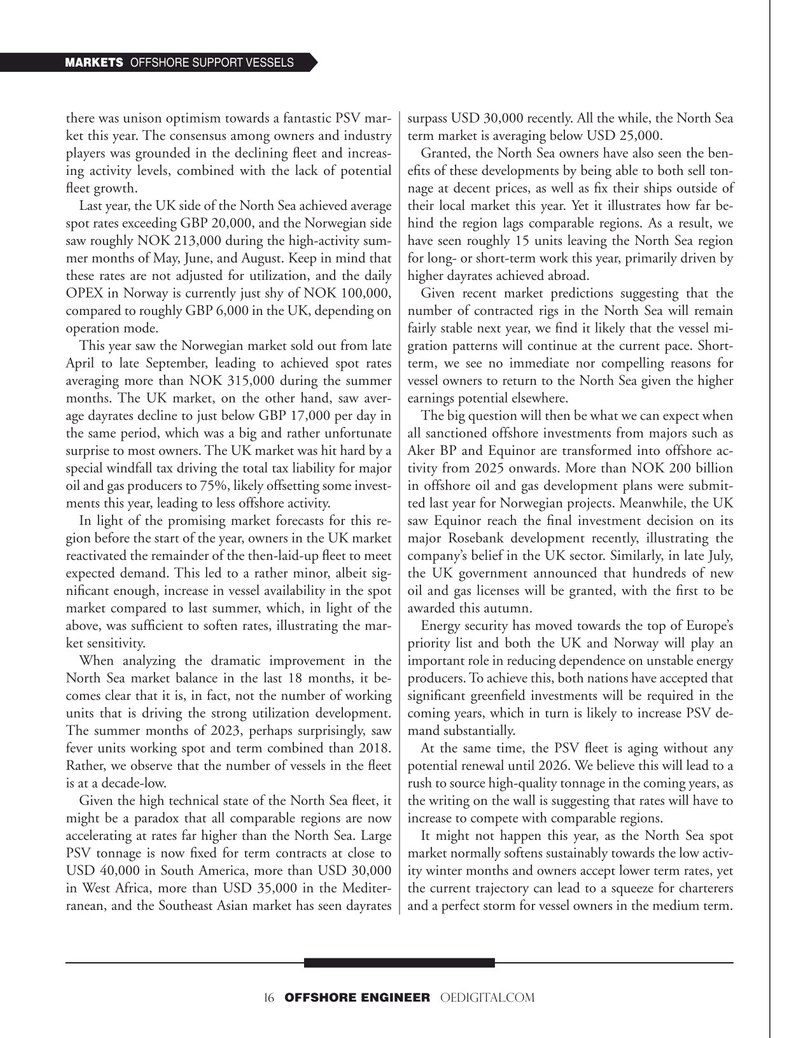
Page 15: of Offshore Engineer Magazine (Sep/Oct 2023)
Read this page in Pdf, Flash or Html5 edition of Sep/Oct 2023 Offshore Engineer Magazine
MARKETS OFFSHORE SUPPORT VESSELS there was unison optimism towards a fantastic PSV mar- surpass USD 30,000 recently. All the while, the North Sea ket this year. The consensus among owners and industry term market is averaging below USD 25,000.
players was grounded in the declining ?eet and increas- Granted, the North Sea owners have also seen the ben- ing activity levels, combined with the lack of potential e?ts of these developments by being able to both sell ton- ?eet growth. nage at decent prices, as well as ?x their ships outside of
Last year, the UK side of the North Sea achieved average their local market this year. Yet it illustrates how far be- spot rates exceeding GBP 20,000, and the Norwegian side hind the region lags comparable regions. As a result, we saw roughly NOK 213,000 during the high-activity sum- have seen roughly 15 units leaving the North Sea region mer months of May, June, and August. Keep in mind that for long- or short-term work this year, primarily driven by these rates are not adjusted for utilization, and the daily higher dayrates achieved abroad.
OPEX in Norway is currently just shy of NOK 100,000, Given recent market predictions suggesting that the compared to roughly GBP 6,000 in the UK, depending on number of contracted rigs in the North Sea will remain operation mode. fairly stable next year, we ?nd it likely that the vessel mi-
This year saw the Norwegian market sold out from late gration patterns will continue at the current pace. Short-
April to late September, leading to achieved spot rates term, we see no immediate nor compelling reasons for averaging more than NOK 315,000 during the summer vessel owners to return to the North Sea given the higher months. The UK market, on the other hand, saw aver- earnings potential elsewhere.
age dayrates decline to just below GBP 17,000 per day in The big question will then be what we can expect when the same period, which was a big and rather unfortunate all sanctioned offshore investments from majors such as surprise to most owners. The UK market was hit hard by a Aker BP and Equinor are transformed into offshore ac- special windfall tax driving the total tax liability for major tivity from 2025 onwards. More than NOK 200 billion oil and gas producers to 75%, likely offsetting some invest- in offshore oil and gas development plans were submit- ments this year, leading to less offshore activity. ted last year for Norwegian projects. Meanwhile, the UK
In light of the promising market forecasts for this re- saw Equinor reach the ?nal investment decision on its gion before the start of the year, owners in the UK market major Rosebank development recently, illustrating the reactivated the remainder of the then-laid-up ?eet to meet company’s belief in the UK sector. Similarly, in late July, expected demand. This led to a rather minor, albeit sig- the UK government announced that hundreds of new ni?cant enough, increase in vessel availability in the spot oil and gas licenses will be granted, with the ?rst to be market compared to last summer, which, in light of the awarded this autumn.
above, was suf?cient to soften rates, illustrating the mar- Energy security has moved towards the top of Europe’s ket sensitivity. priority list and both the UK and Norway will play an
When analyzing the dramatic improvement in the important role in reducing dependence on unstable energy
North Sea market balance in the last 18 months, it be- producers. To achieve this, both nations have accepted that comes clear that it is, in fact, not the number of working signi?cant green?eld investments will be required in the units that is driving the strong utilization development. coming years, which in turn is likely to increase PSV de-
The summer months of 2023, perhaps surprisingly, saw mand substantially.
fever units working spot and term combined than 2018. At the same time, the PSV ?eet is aging without any
Rather, we observe that the number of vessels in the ?eet potential renewal until 2026. We believe this will lead to a is at a decade-low. rush to source high-quality tonnage in the coming years, as
Given the high technical state of the North Sea ?eet, it the writing on the wall is suggesting that rates will have to might be a paradox that all comparable regions are now increase to compete with comparable regions. accelerating at rates far higher than the North Sea. Large It might not happen this year, as the North Sea spot
PSV tonnage is now ?xed for term contracts at close to market normally softens sustainably towards the low activ-
USD 40,000 in South America, more than USD 30,000 ity winter months and owners accept lower term rates, yet in West Africa, more than USD 35,000 in the Mediter- the current trajectory can lead to a squeeze for charterers ranean, and the Southeast Asian market has seen dayrates and a perfect storm for vessel owners in the medium term.
16 OFFSHORE ENGINEER OEDIGITAL.COM

 14
14

 16
16